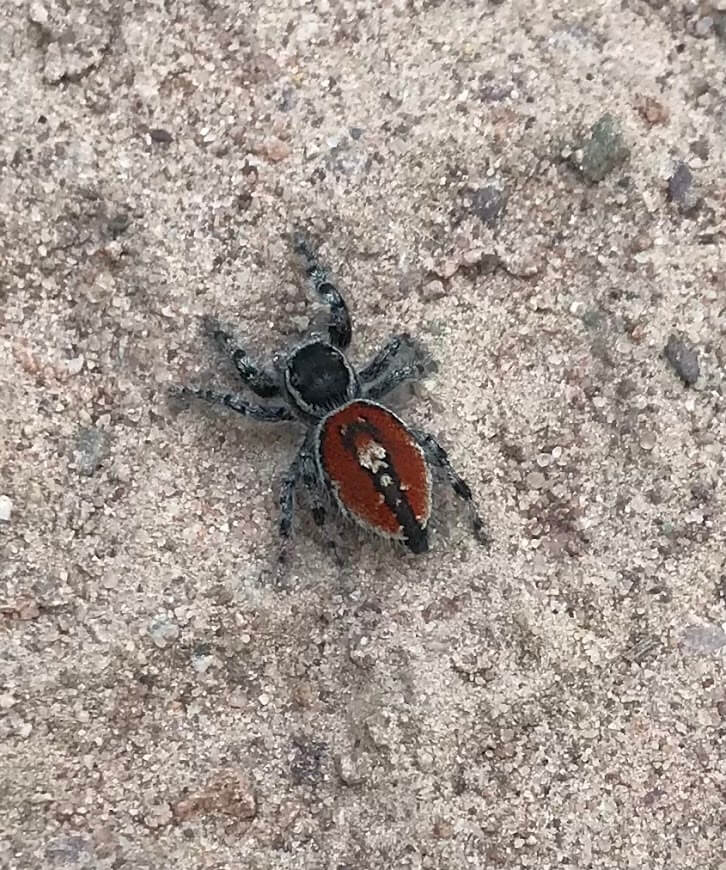Terrible & Beautiful
By Kindle Lewis
Broadcast 7.26 & 7.29.2023

Tyrell’s tufted jumping spider: a beauty! Photo © Kindle Lewis.
Listen:
It’s a rare smoke-less late-summer day in western Montana, one of those perfect days in which the heat is obvious but not suffocating and a cooling breeze pushes fluffy, imagination-stirring clouds across the blue sky. I’m hiking along a familiar trail, not because it’s a perfect day to be outside, but because I am drowning in grief. I have just learned that my dad is going to die in a few short months. Sometimes the mountains call to us to rest and bask in the beauty and wonder they provide; other times they call to us to escape the existential bogs that trap us as humans. This hike, on this perfect summer day, is to escape one such bog.
On my escape, I am trying to ground myself amongst the maelstrom of emotions I’m trapped in by focusing on the familiar, monotonous act of moving. On this perfect and terrible day, surrounded by the smell of warm pine and bird song, I focus on my steps: watching one foot crunch on the gravel followed by the other, and feeling the breath in my lungs.
Crunch, crunch, breathe. Crunch, crunch, bre—gasp!
Suddenly, and alarmingly, my foot is falling in slow motion towards something much larger than the surrounding gravel bits, fuzzy, and blazingly red. Here in the middle of the gravel sea is a stunning, breath-catching spider the size of a quarter: Phidippus tyrelli, or Tyrell’s tufted jumping spider.
What has stalled my breath, and my foot, is neither the size of the spider nor the grey- and- black- striped fuzzy legs, but the intricate design on its back. Although males of this species have a solid holly-berry red abdomen, along the center of this female’s back is the pattern that distinguishes the sexes of this species. On this shocking beauty of an arachnid, a black stripe bisects the red abdomen, widening as it approaches the spider’s head and is adorned with white and yellow markings, giving the illusion of a sinister insect riding atop the spider. So effective was this illusion to my tear-filled eyes that I got as close as my courage would allow to inspect this oddity.
Tyrell’s tufted is one of many creatures that use mimicry to help ensure survival and one of a large number of jumping spiders that have evolved patterns on their abdomens mimicking Multillidae: a family of wasps whose defensive stings are extremely painful. But why would this jumping spider evolve to look like a dangerous wasp?
Tyrell’s tufted, along with most jumping spider species, is not aggressive, nor is its bite dangerous to humans. Jumping spiders are the hunters of the arachnid world and actively hunt their food using their speed. They also have the ability to increase blood flow to their back legs, allowing them to pounce on prey rather than building webs to trap their food. Since jumping spiders need to explore terrain for smaller creatures to feed upon, they are also preyed upon much more frequently than their web-building cousins. The females of Tyrell’s tufted have evolved to look dangerous to deter predators from taking the risk of attacking them.
On this perfect and terrible day, I spend the rest of my hike steeped in curiosity about this arresting species. Later in the day I sit next to my dad while we Google everything we can find about Tyrell’s tufted. I will forever be grateful to that spider for that memory and for reminding me of all the wonder and joyous moments that exist within those existential bogs.
Every week since 1991, Field Notes has inquired about Montana’s natural history. Field Notes are written by naturalists, students, and listeners about the puzzle-tree bark, eagle talons, woolly aphids, and giant puffballs of Western, Central and Southwestern Montana and aired weekly on Montana Public Radio.
Click here to read and listen to more Field Notes. Field Notes is available as a podcast! Subscribe on Apple Podcasts or wherever you listen to podcasts.
Interested in writing a Field Note? Contact Allison De Jong, Field Notes editor, at adejong [at] montananaturalist [dot] org or 406.327.0405.
Want to learn more about our programs as well as fun natural history facts and seasonal phenology? Sign up for our e-newsletter! You can also become a member and get discounts on our programs as well as free reciprocal admission to 300+ science centers in North America!












